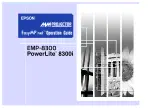
CHAPTER 4
OPERATION
4-8
DT-203P, DT-105P and DT-110P display series
4.8
Protocols
4.8.1
Protocol 512-M.
512-M designates the 2048 protocol for managing control messages with variables. The
messages are encoded in binary and using 11 inputs, the 2048 messages are controlled. (2E11 =
2048).
4.8.1.1
Displaying only one message.
It is the easiest way to send an only message to the display. The direction of the message
must be sent to the display inputs in binary code.
The message number must be codified to D0-D8, CT1 and CT2 inputs and keep it activated
for the period of time it is wished to be displayed. The display always shows the message whose
direction is applied.
This method neither memorise the messages nor allows codifying the variables. SM, SV
and SR control signs are not used in this method, which means that they must be activated.
Inputs:
SM, SV and SR =
‘1’ (activated)
D0-D8, CT1, CT2 = binary code
The maximum number of messages to be sent is 2048 messages by using 11 PLC outputs.
The number of PLC outputs required depends on the number of messages wished to be sent.
For example, to send 52 messages it is required to use 6 PLC outputs, which allows sending 64
messages, from the message nº 0 to message nº 63.
When the display is used to display only one message, PLC outputs can be static or relay
outputs.
4.8.1.2
Displaying all messages in EEPROM
DT-105P, DT-110P and DT-203P displays allow the entry of variables to insert in permanent
texts of the programmed messages. This value must be send externally by way of the parallel inputs
of the display.
The external variables are useful tools, which allow introducing numeric and ASCII values in
the messages or modifying them depending on the situation. For example, it can be displayed a
counter of pieces, the temperature degree, a variable of a process, etc.
A total of 16 variable characters can be associated for every line, which can be in groups or
isolated messages, and which is ordered by a position counter (see 4.7





































